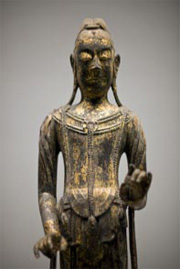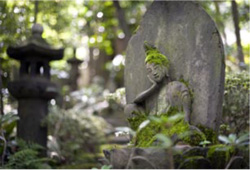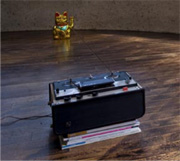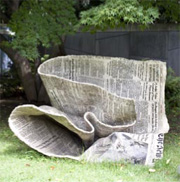Home > Highlighting JAPAN > Highlighting Japan OCTOBER 2012 > Nezu Museum/Hara Museum of Contemporary Art
Highlighting JAPAN
[SERIES] THE NATION'S MUSEUMS
Nezu Museum/Hara Museum of Contemporary Art
Tokyo is home to literally hundreds of museums, including many art museums. Julian Ryall pays a visit to two contrasting gems among the capital's impressive collection: Nezu Museum and the Hara Museum of Contemporary Art. Both are located in tranquil surroundings in the heart of the city.

Standing Kannon (Avolokitesvara), gilded wood, seventh-century Asuka period, Japan
Credit: ROB GILHOOLY
Anyone who admires works of ancient to pre-modern art from Japan and across Asia has good reason to thank the Nezu family.
Industrialist Kaichirō Nezu spent his own money on purchasing some of the best examples of Japanese art in the early decades of the last century, when it had little appeal in this country and was being snapped up by overseas collectors. After his death in 1940, his son, also named Kaichirō, opened the Nezu Museum on the site of the family's spacious residence in Aoyama, surrounded by a garden with a pond and dotted with teahouses. The third generation of the family, Kōichi Nezu, has continued the work of his ancestors and the collection has grown to more than 7,400 items, ranging from works of calligraphy to paintings, sculptures, ceramics, lacquerware, metalwork, bamboo crafts and textiles.
"It would be difficult to choose one work that is a highlight of the collection, but one of the most famous is the folding-screen painting 'Irises,'" says Yukiko Shirahara, chief curator of the museum. The pair of sixfold screens was created by Ogata Kōrin in around 1705 and is truly a sublime sight to behold. Another remarkable item is the Shintō painting titled "Nachi Waterfall," created in the late Kamakura period (1185–1333).

Stone carvings in the museum's gardens
Credit: ROB GILHOOLY
The gardens, which roll over more than 20,000 square meters, hold another collection of artworks. No fewer than four teahouses are arrayed along the banks of the pond below the main building. The paths through the carefully tended gardens are punctuated by Buddhist statues and beautifully wrought carvings that are a surprise at every turn.
All in all the museum seems a world away from the chic and bustling Aoyama neighborhood that has grown around the former Nezu family residence.

"Popular Critics," by Indonesia-based Duto Hardono
Credit: ROB GILHOOLY
When it first opened its doors in 1979, the Hara Museum of Contemporary Art was one of the first institutions to focus on contemporary art in Japan. More than thirty years later, it is still breaking new ground.
"Three decades ago, contemporary art was basically taken to mean works influenced by Western art," says Atsuo Yasuda, director of the curatorial department at the museum, "but world has changed a great deal since then. Japanese society and culture are increasingly looking towards other Asian countries for contemporary art. The contemporary art scene is really much more global now, a blend of East and West, North and South, and we hope our exhibitions can show that," he says.
A stroll through the galleries and the museum's garden demonstrates the museum's philosophy.
The works of Afghan artist Khadim Ali are delicate and precise, utilizing gold leaf on paper to tell a story through four works. These exhibits are part of the "Home Again —10 Artists Who Have Experienced Japan" show which runs until November 18. Another piece in the exhibition is an installation by Duto Hardono, who is based in Indonesia, titled "Popular Critics" and features an old-fashioned reel-to-reel tape recorder with the tape spooled around a golden statue of a cat and replaying the sounds of a crowd clapping.

"Newspaper-84-E" by Kimiyo Mishima
Credit: ROB GILHOOLY
The garden nestles in the angles of the museum buildings, including the original residence that stood on the site, and was constructed in 1938. One of the few surviving works of Jin Watanabe, well known for his design of the Tokyo National Museum, it captures early-Showa period (1926–1989) architecture as it adopted European styles.
"The design of the building is unique and it provides a great atmosphere in which to see works of art," Yasuda says. "Since the 1970s, artists have become far more conscious of the space in which they are displaying their works and that has become part of the artist's expression."
The museum houses more than 1,000 items of cutting-edge contemporary art, including pieces by up-and-coming artists, and changes its exhibitions as frequently as four to six times a year.
It's a museum you will want to return to again and again.
© 2009 Cabinet Office, Government of Japan






